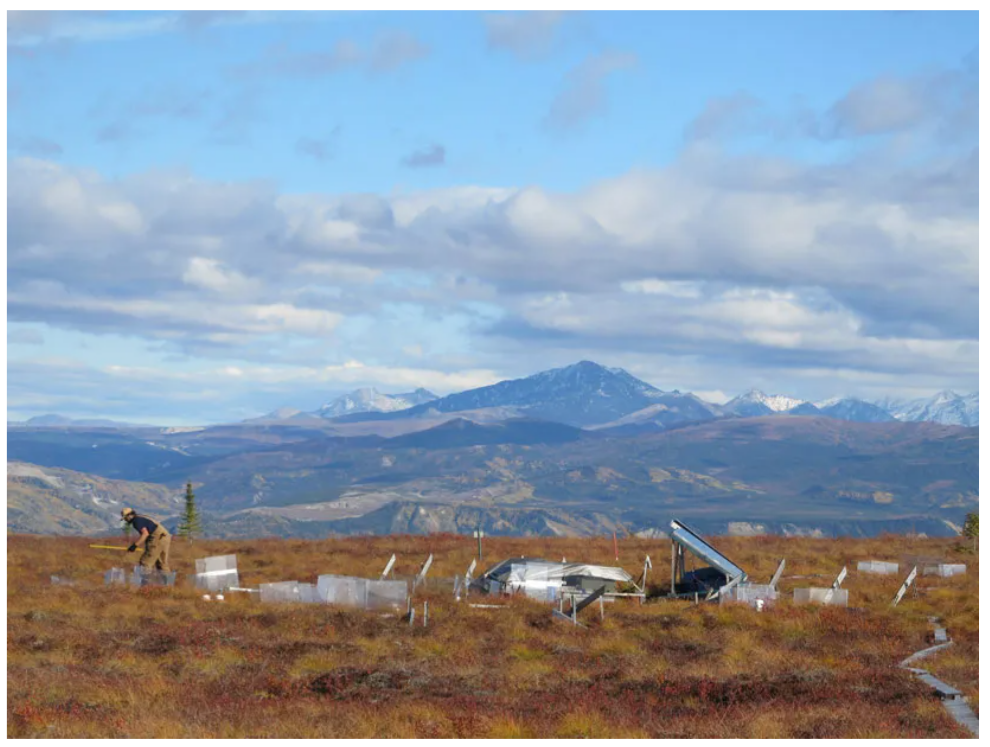Nitrogen released into the soil from thawing permafrost in the Arctic could accelerate soil carbon decomposition and alter carbon dynamics, with global implications.
The Arctic is warming 2–3 times faster than the global average. The rapid increase of near-surface air temperatures at high latitudes is driving a loss of ice in oceans, rivers, mountain glaciers, and soil.
Permafrost, the perennially frozen ground found in frigid climates, is estimated to store approximately 1,500 gigatons of carbon, or about half of the world’s underground stores. This carbon is slowly escaping from the soil as permafrost thaws; this thawing could release as much carbon into the atmosphere as current emissions from global land use change over the next 80 years.
Like many other models of future conditions, uncertainty plagues the estimates of permafrost carbon release. Salmon et al. explored how nitrogen, an important contributor to this uncertainty, interacts with carbon in thawing soils. Nitrogen is an essential nutrient for plants and soil microbes but occurs in limited supply in tundra soils.
This limitation restricts plant growth and microbial decomposition, which are critical pieces of the carbon cycle.
The researchers drilled soil cores at the Eight Mile Lake site in interior Alaska to depths of 85 centimeters to evaluate the annually thawed active layer (0–55 centimeters) as well as the upper permafrost (below 55 centimeters). They then incubated the soil cores at 15°C for about 8 months and measured the subsequent nitrogen levels and microbial biomass. The data collected in the incubation informed statistical models that were used to analyze the effects of depth, time, and growing season conditions on nitrogen and carbon dynamics.
The findings revealed that both carbon loss and microbial biomass decreased significantly with soil depth. Models predicted that soil decomposition would release the largest amount of mineral nitrogen from soils located in the middle of the active layer. Permafrost soils at the bottom of the soil profile, however, released a large flush of mineral nitrogen during the initial thaw but a small flux of mineral nitrogen during subsequent decomposition. These patterns indicate that microbes near the soil surface are nitrogen limited, whereas deep microbial communities are more limited by carbon.
The team’s calculations estimate that mineral nitrogen released from the soil profile would increase tenfold during the first 5 years of permafrost thaw. Should permafrost continue to thaw in the Arctic, these results suggest that tundra ecosystems may experience an increase in nitrogen availability that exceeds plant and microbial demands. Excess nitrogen, in turn, could precipitate increased decomposition of soil carbon and increased levels of nitrogen in streams draining from thawing permafrost landscapes.
The study offers critical insights into how warming temperatures in the Arctic could dramatically increase permafrost thaw and initiate profound changes in carbon and nitrogen cycling in tundra ecosystems.

The warming climate at northern latitudes drives changes to permafrost soils that are still not well understood. Here a researcher measures fall thaw depth at the Eight Mile Lake study site in interior Alaska. Photo by, Verity G. Salmon.
Citation, Sidder, Aaron. (2018), How nitrogen contributes to permafrost carbon dynamics, Eos, 99, https://doi.org/10.1029/2018EO107611.

